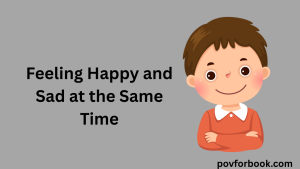There are moments in life when emotions blend in ways that words struggle to describe. You might feel overjoyed but also deeply heartbroken. These mixed emotional states are incredibly human and, surprisingly, quite common. Thankfully, the English language—and even a few borrowed foreign terms—offers us powerful words that capture this complex emotional cocktail.
In this article, we’ll explore 10 words for feeling happy and sad at the same time—each with a deep explanation that unpacks its emotional weight. These words will not only help you express yourself more clearly but also help you understand the emotional richness of the human experience.
Let’s deeply describe 10 Words for Feeling Happy and Sad at the Same Time

1. Bittersweet
This is one of the most popular and accurate words for expressing mixed feelings of happiness and sadness. Bittersweet is often used during moments of transition—like a child moving out, retiring from a long career, or saying goodbye to a loved one. The “sweet” part is the memory or joy that warms your heart, while the “bitter” side reminds you it’s gone or changing. It’s a word that holds both joy and pain together like two sides of the same coin.
2. Melancholy
While commonly associated with sadness, melancholy is more poetic and profound. It’s not just being sad; it’s a reflective sorrow often mixed with a quiet peace. Think of a cloudy day where you don’t feel bad, but there’s a deep emotional stillness. Melancholy doesn’t always demand tears—it simply asks for stillness and thought. It’s where sadness meets comfort.
3. Nostalgia
Nostalgia is that warm, aching emotion you feel when remembering good times from the past. You feel happy that they happened, but also sad that they’re gone. Old songs, childhood places, or a long-lost friend can trigger nostalgia. It’s a powerful emotional blend—one that often brings a tear to your eye while making your heart smile. It is memory’s way of hugging you.
4. Wistful
To be wistful is to feel a deep longing for something lost, something that might never return. It’s not full-blown sadness—it’s more of a dreamy sadness, like looking out of a window on a rainy day thinking about a love that slipped away. Wistfulness carries a tone of gentle regret or yearning, filled with both beauty and sorrow. It’s when hope lingers, even in the absence of reality.
5. Poignant
A poignant moment is emotionally touching in a deep and often bittersweet way. It may not be overwhelmingly happy or sad, but it’s so emotionally powerful that it stays with you. For instance, watching an elderly couple holding hands, or reading a letter from a deceased loved one—these moments feel poignant. They’re moving, filled with emotional weight, and often leave us feeling both uplifted and a little heartbroken.
6. Ambivalent
While not exclusive to emotional situations, ambivalent perfectly captures that feeling of emotional contradiction. You may feel ambivalent about ending a relationship—you know it’s the right decision, but it still hurts. Or when you leave your hometown for a dream job elsewhere. You’re excited, yet something inside you grieves the change. Ambivalence is where happiness and sadness live side by side.
7. Saudade
This beautiful Portuguese word doesn’t have a direct translation in English. Saudade describes a deep, emotional longing for someone or something you love but have lost—or may never return. It’s missing a moment, a person, a place, with both sadness and appreciation in your heart. Saudade is about cherishing what was while grieving its absence. It is often used in poetry, music, and literature for this exact emotional duality.
8. Hiraeth
A Welsh word with no perfect English match, hiraeth conveys a nostalgic yearning for a home you can’t return to—or maybe one that never really existed. It’s homesickness on a spiritual level. It’s what you feel when you remember how life used to be or long for a simpler time. It’s the ache of not just wanting something, but mourning its loss, even if you never fully had it. Hiraeth is powerful, poetic, and deeply emotional.
9. Blue
Though simple, blue can express a unique emotional state. In music, art, and culture, “feeling blue” isn’t just about sadness—it’s a soulful feeling that includes reflection, vulnerability, and even quiet contentment. Blues music, for example, explores love, loss, joy, and pain all in one song. The color blue, emotionally, has depth—it allows you to feel fully, whether you’re celebrating or healing.
10. Sentimental
When you’re sentimental, you’re emotionally moved by memories, keepsakes, or even certain smells or songs. It’s when you cry reading an old letter or smile through tears watching a childhood video. Sentimentality connects joy with sorrow because the memories were beautiful—but they’re no longer your present. It’s emotion built on value and memory, both comforting and heart-wrenching.
Why Do We Feel Happy and Sad at the Same Time?
Life is layered, and emotions often overlap. Big changes, goodbyes, reunions, or even achieving a long-term goal can bring a mix of joy and sorrow. This emotional duality is not a weakness—it’s a strength. It shows emotional depth, maturity, and awareness. We are capable of holding more than one emotion at once, and that’s part of being human.
FAQs about Feeling Happy and Sad at the Same Time
Q1: What is the most common word for feeling happy and sad at the same time?
The most commonly used word is bittersweet. It perfectly blends joy and sorrow, often used when describing moments like farewells, graduations, or memories that are both joyful and painful.
Q2: Are these feelings normal?
Absolutely. It’s very normal to feel happy and sad at the same time. This emotional mix often happens during life transitions, personal growth, and when reflecting on the past.
Q3: What’s the difference between melancholy and nostalgia?
Melancholy is a quiet, reflective sadness that can arise for no clear reason, while nostalgia is triggered by memories—it’s a longing for the past. Both carry emotional depth, but nostalgia is more memory-focused.
Q4: Is “saudade” used in English?
While saudade is a Portuguese word, it’s often borrowed by English speakers, especially in poetry or music, to describe a very specific kind of emotional longing that doesn’t have a direct English equivalent.
Q5: How can I use these words in daily conversation or writing?
Use them to describe emotional moments more precisely. For example:
- “Graduation day felt bittersweet.”
- “Looking through our wedding album filled me with nostalgia.”
- “I felt a strange melancholy as the summer ended.”
These words add depth and authenticity to your communication.
Conclusion
Emotions are complex. They don’t come in neat packages. Sometimes you cry while laughing, or feel grateful while grieving. That’s the beauty of human emotion—it’s full of contrast. The 10 words we’ve explored—bittersweet, melancholy, nostalgia, wistful, poignant, ambivalent, saudade, hiraeth, blue, and sentimental—help us give voice to those feelings that exist in the in-between spaces of joy and sorrow.
Understanding and using these words won’t just enrich your vocabulary—they’ll help you connect with others on a deeper level. Because when you can name your emotions, you can understand them. And when you understand them, you heal, grow, and live more fully.
Read related articles:
17 Other Ways to Say “In My Opinion” in an Essay
20 Other Ways to Say “Important”
More Than 20 Alternatives to Say “Second Chance”
Deven Kumar is the passionate writer and founder behind povforbook.com, a website dedicated to exploring unique perspectives in literature and storytelling. With a deep love for books, language and traveling, Deven aims to inspire readers by sharing insightful reviews, thought-provoking synopses, Guiding tourist by sharing personal experience and engaging content that highlights the power of narrative. When not writing, Deven enjoys connecting with fellow book lovers and traveling lovers and continuously discovering new voices in the literary world.
